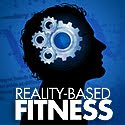 I recently purchased and read the e-book Eat-Stop-Eat from nuritionist Brad Pilon. I first heard Brad interviewed a little while back on a podcast (can't remember which one, sorry) where he explained his method for losing bodyfat called flexible-intermittant-fasting. Needless to say I was intrigued since much of what Brad was saying was flying in the face of nutrional recommendations that I subscribe to and have used for years!
I recently purchased and read the e-book Eat-Stop-Eat from nuritionist Brad Pilon. I first heard Brad interviewed a little while back on a podcast (can't remember which one, sorry) where he explained his method for losing bodyfat called flexible-intermittant-fasting. Needless to say I was intrigued since much of what Brad was saying was flying in the face of nutrional recommendations that I subscribe to and have used for years!Listening to Brad speak definately gave me a case of congnitive dissonance, which is that feeling you get when something contradicts a deeply held set of beliefs or convictions. Being very much a science and evidence-based person, I knew that I needed to examine my own nutritional beliefs. For years I have recommended and followed the principles of meal frequency(4-6 small meals/day) to control blood sugar, build muscle, and lose bodyfat. This methods has worked pretty well for me and many I have recommended it to.
Brad's basic view however, is that this style of eating promotes a chronically elevated insulin level, which can increase fat stores as well as increase inflammation and other negative health markers in the body over time. I'm not sure I buy into this completely as I don't seem to have any of those effects (not yet at least). But from an evolutionary perspective, it kind of makes sense that are bodies are meant to go for longer periods of time without food. And this is where Brad's system of flexible-fasting come in to play. He simply advises to choose one or two non-consecutive 24-hour periods (at most) per week to restrain from food while drinking non-caloric beverages liberally. He even advises exercising on these days!
While this sounds brutal to some (as it did to me), the results people are getting on his program seem pretty significant. What's kind of refreshing too, is that Brad simply dismisses many of the myths about short-term (24 hour periods) fasting such as:
1) you'll lose muscle (he says you won't, especially if you are resistance training 2-3x/week)
2) you'll enter the starvation mode and then store fat next time you eat (not so according to Brad who gives many scientific references to back this up_
3) you'll feel terrible and have no energy (after the few fasts, he says you feel great and get a lot of work done without worrying about eating all day)
Also, Brad dismisses much of the debate over protein, carbs, and fat intakes and simply recommends eating a healthful diet (lots of fruits and veggies, lean proteins, etc..) on the days you eat without any real need follow any strange and restictive diet plan with expensive supplements and fibers pills, etc... The one or two 24-hours periods you don't eat make for a great caloric deficit over the course of the week that you will lose fat. The real key is to eat normally on your regular days and not try to "make-up" for lost feeding opportunities. Also, you never actually need to miss a day of eating. Instead, Brad recommends choosing a time, say 2 PM one day until 2 PM the next day to fast. Any time will work though, according to Brad.
I will give this eating plan a try once my track season is over and report my findings in my blog. I'm not trying to lose weight per se but maybe will lose a little "love-handles" fat that I've accunulated as I got into my 30's. I haven't had any clients try it yet but am starting to think this might be a great eating style for many of fat-loss clients or anyone who wishes to save money on their grocery bill!
To read more about this very fascinating book or to purchase your own copy, go to
http://www.eatstopeat.com/?tid=newblog or Brad's personal blog: http://bradpilon.com/ to read more about his recommendations.












